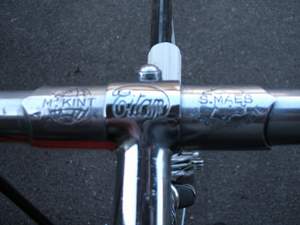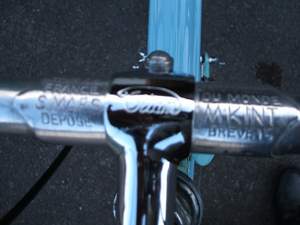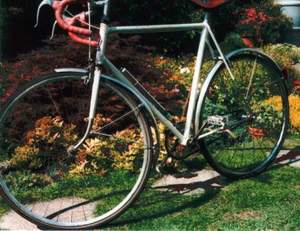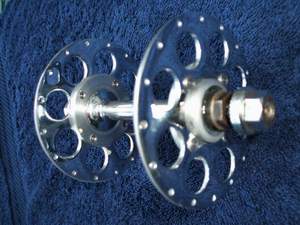Vol. 1, Issue 22
Posted: Thursday 18th June 2020
Some readers may well wonder what C L N is all about. Several years ago I felt that Patricia and I were out on a limb with regards to meeting lightweight enthusiasts to exchange ideas. Then we were lucky enough to meet Mervyn Cook and Tony Beckett at a V-CC event and we had a long and interesting chat about what we were all doing. When I got home I sent them an email with an attachment to list the machines we had and what work was planned for the immediate future. After a couple of messages back and forth other members gradually got included by request and we have kept it up ever since. Nowadays it goes out to 50 or 60 readers in the UK, Japan, USA and now Italy (Venice). I guess you probably know that I try to time the editions to fill the gap between editions of N & V hopefully so as to reduce the withdrawal symptoms of the two month gap.
Our first ‘big’ event of the year is always the Boot and Back and this year the weather was kinder than it was in 2004 as it didn’t rain at all. I rode my Hetchins Magnum Bonum and Patricia took her Gillott Spearpoint. During the winter months we usually keep about three machines for each of us fitted with mudguards but then reduce this to about one in the summer. During the winter road surfaces can be a bit gritty so this precludes machines with tubs: now we are anticipating the better weather and planning to take any machine which takes our fancy on the day.
I realise that we are plumbing new depths of sadness in trying to trace the provenance of a stem and bar set which Dudley (Cheal) kindly bought for Patricia at a recent jumble at Bethersden in Kent . The seller explained to Dudley that he had used them as an Independent rider in the first Dover to London BLRC road race. Does anyone happen to know who this is? It is a Titan/GB engraved set-up with the ‘M Kint’ engraving as opposed to the later ones with ‘A Schotte’ as well as Kint.
I had the stem replated at Prestige Plating and luckily the bars polished up really well. I have just fitted them to Patricia’s 1948 Hobbs Superbe and they have really brought it to life – amazing how such a small detail can do this. The Hobbs has a Sturmey FM on 26” Conloys (Airlite front) with BSA 5-pin chainset and the early narrow GB levers and Hiduminium stirrups. I also gave the frame a cut-back and polish and fitted some Olympic bands on the seat tube either side of the Hobbs badge. Patricia cleaned out all the dried up polish around the lugs using a toothbrush – this revealed the gold lining which was lurking behind. When we took it on one of our section rides several members thought that it was a different machine.


The markings on these GB bars are as follows: the early ones (Patricia’s Hobbs – above left) engraved “Tour de France”, “S. Maes” and “Depose” on the left side plus “Champione du Monde”, “M Kint” and “Brevette” on the right. The later ones (on my Hetchins – above right) are more pictorial having an engraved globe on the left with “M. Kint” around the Equator and “A. Schotte” underneath the globe. On the right they have an outline map of France with “S. Maes” across the middle and “Depose Brevette” across the bottom. They seem always to come paired up with Titan stems.
Mervyn Cook tells me that Maes-Kint bars and Titan stems were advertised for sale pre-WW2. He has an early pair with ‘TYPE’ in caps over ‘Maes’. in upper and lower case script on the left and ‘GB’ in upper case script over ‘ENGLAND’ in small caps on the right. We wondered if they were pre-war but Davis Palk says that the first (pre-war?) ones had two locating pins to stop the ferrule rotating on the bars. This could mean that Mervyn’s were possibly just post-war as they did not have these locating pins.
Why all this minutiae you may well wonder. Well one day you may accidentally cross the borders into Hampshire with your ‘pride and joy’ shiny lightweight, only to come face to face with the Hampshire Style Police manning the border post. Imagine your horror when you are publicly castigated for having a late 50s stem/bar set on an early 50s or, horrors, late 40s machine – in the case of a second offence you could end up with the whole thing blow-torched. Be warned.
On weekend 19/20 March we polished two of our machines, checked the specifications carefully (see above) and joined the Hampshire Section for Barry Donaldson’s Whitchurch ride. As is always the case with this section’s rides we had a great weekend and were made more than welcome. Barry was rewarded with a turnout of 23 riders, all on beautiful machines. I took my 1951 Bates Vegrandis on fixed and Patricia took her Hetchins Swallow track in its unusual original paint job.
The Hetchins also has a lovely R O Harrison ‘lapped’ stem with a cut down pair of South of France bars which suit the machine perfectly. My Bates had Conloy Asps on Harden LF D/F hubs, Chater chainset, Swallow saddle, GB spearpoint alloy stem and Maes bars fitted with a single front brake and a ‘dinger’ bell. I wanted to replicate a 50s time trial bike and was pleased with the end result. Smugness showing here I guess. The paint job, which was a copy of the original, attracted some attention as the main triangle is a bright red with yellow forks and rear triangle, the frame had just come back from C & G at Liverpool and, as usual, Gerry had done a superb job for us.
As is always the case when I was fitting the Chater chainset to the Bates, the chainring waved from side to side as I spun it. Why, I wondered, do I always get the warped sets? It seems that I am not the only one as, at the Whitchurch ride lunch stop, I heard David Palk explaining to someone how to cure this – he remarked that he had to do it with every Chater chainset he fitted. To think I always thought that Chater were supposed to be an example of British engineering at its best.
David explained that the makeshift tool needed is a very large adjustable spanner plus an old toestrap fitted to the jaws to protect the chrome. Fit the chainset minus ring to the BB axle in the frame. If you have a two arm set then the crank fitting obviously has to be the datum point, if not you can choose whichever one of the three you think will give you the best chain line. David sticks Bluetack on the chainstay as a datum mark. He then tweaks the other two arms using the spanner to align them until they line up with the blue tack. When satisfied with this he fits the ring and re-uses the Bluetack (would David do anything else!) to mark the chainstay distance to the ring which is then tweaked in the same way.
On arriving home I had a go and with little time to spare managed to make some improvement. Then I began to wonder if the rings are ever concentric as the chain tightens and slackens as it goes round, as do all my machines on fixed which have Chater chainsets. I guess there is nothing you can do about this with Bluetack, a spanner and an old toestrap!
With reference to the Gillott Tapertube mentioned in C L N 21, Neil Foddering writes to me: “In case you haven’t had a response yet to your musings regarding the Gillott Tapertube bottom bracket shell, I can confirm that they were made specifically for this tubing which was made available to any frame builder, and apart from Gillott, taper tube frames were made by, or available from, Selbach and Granby from the 1920’s onwards, Holdsworth, Vindec, Paragon, and no doubt others.”
The 1939 Brown Brothers Cycle accessories catalogue lists both taper tube bottom bracket shells and Reynolds and Accles & Pollock taper tubing, Neil sent me a copy of the relevant page. Not only that, he told me of a bookseller who had a copy of the 1952 Brown Bros. catalogue which I now own. Does anyone know if they produced a catalogue between the years 1939 and 1952? They are very useful as reference points.

Here is a Carpenter machine which was purchased by reader Ray Miller’s mother in 1950. It was built to special order at their premises in Kingston, Surrey, and was regularly raced in time trials by her as a member of the Surrey Roads Cycling Club. It is a rare example of a 50s machine which has been in the hands of one owner since built. The 24” frame has 73/71 angles. The front rim is the original Conloy built on a Le Tour hub. The entire rear wheel has been replaced and is now a steel rim and Maillard hub.
The cranks are 6 ½” Chater-Lea and it has a Reynolds 2 ½” bar extension, GB side pull brakes and levers. Unfortunately Ray’s mother doesn’t recall much about the Carpenter shop or what model the frame is. When Patricia and I lived in London a few years ago Carpenter’s shop was still there just North of Kingston Bridge but like many others was selling mainly mountain bikes.
I think I mentioned that we recently acquired one of the pre-war Airlites (front) which have a steel barrel plus a small alloy pressed on flange which then has large steel flanges rivetted on, it was in a very sorry state with all the chrome gone. An engineer friend of mine took it apart for us and sent the barrel and flanges to be replated at Prestige Plating who made a grand job of them, managing to preserve the logo inscription on the barrel. Colin then re-rivetted the whole assembly together and the hub now looks absolutely stunning (see below). The plan is to build the hub into a wheel to match a Sturmey rear on one of Patricia’s 40s machines. We are looking for a 26” 32 hole Dunlop Alloy HP rim to do this. Several immediate post-war machines would have had pre-war components on them as there was an acute shortage of bits at this time.
Tom and Beryl Jeffery have got a pair of these rivetted Airlites on their tandem which is a 1939 Claud Butler SWB model. I think I am right in thinking that Airlites used to produce a special front hub for tandems which uses an axle of the same diameter as the rear. (I have just checked Tom’s and although the front hub is wider across the flats and has larger diameter flanges, he tells me that the axle is the same diameter as other front Airlites. (Not fatter.) When you look at Airlite front hubs the barrel is very slim which is one of the reasons that they look so attractive.

We have also acquired a pair of the rare Airlite QR spindles and hoped to be able to convert some hubs with them – I am told though that yet again the front barrel has to be wider in diameter as the normal axle is too slim to be hollowed out – there would not be enough strength left. In case you have never seen one, here is an image of our pre-war rivetted Airlite with chrome barrel and the chromed steel flanges mounted on a smaller alloy flange.
Just when you thought that you had heard everything which could be said about hubs, on our section ride I have just seen a 1937 GA fitted with small flanged Hardens – a first for me. Also it was pointed out to me that the Airlites which do have larger diameter front axles (for QR in this case) don’t fit all forks on older machines.
Sunday May 29th 2005 – Cambridge Section ‘Meridian’ Lightweight Ride. The first of our section’s 2 lightweight rides – this is the flat one to encourage you to get out on that that fixed-wheel machine (not compulsory of course), just over 35 miles with coffee and lunch stop. It is always a day to remember for the friendly atmosphere so we would love to see any of you readers of C L N on the ride. As is usual on these rides anyone wanting to see our collection of about 24 lightweights will be welcome to visit after the ride – we live about 2 miles from the P & R. You might even get a cup of tea thrown in! Start 10am at Trumpington Road Park and Ride, Cambridge. Just off Junc. 11 of M11 (A1309). 2 miles from Cambridge railway station. (It is possible that there may be works on the railway line between Welwyn and Stevenage. If so you can travel to Cambridge with a bike from Liverpool Street)
Posted: Thursday 18th June 2020
This article appears in the following categories.
Upcoming Events
Whether you are looking for a gentle social meet up, or a 100-mile ride browse the community’s upcoming events and plan your next weekend outing.
